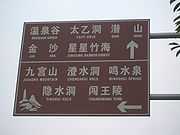Tourist sign
 | |
| Various tourist signs | |
A tourist sign, often referred to as a brown sign, is a traffic sign whose purpose is to direct visitors to tourist destinations,[1] such as historic buildings, tourist regions, caravan or camp sites, picnic areas, sporting facilities and cultural places such as museums. By international convention, brown signs with white lettering and white pictograms are often used for this purpose.
In the mid-1970s, tourist signs were introduced into France.[2] Since that time, the idea of directing tourists to sights and attractions using a uniform type of signage has spread around the world. In Germany these tourist signs were first used in 1984. In is not clear which of the two signs, to Löwensteiner Berge or Burg Teck, was first erected there.
Usage
Basically these tourist signs have 3 main applications:
- Information signs and signposts that point to important tourist destinations or places of interest in the local area, for example within a village or town.
- Standard signs that are used to mark routes with special themes, i.e. so-called tourist or holiday routes.
- Tourist signs that herald the presence of nearby landscapes, towns and regions, usually on long distance routes such as motorways. They are not used as direction signs.
Design

In many countries, the design and use of tourist signs is laid down in order to ensure a uniform appearance. In addition to their typically brown and white colour, sans serif fonts are used that are easy to read. In order to improve legibility for tourists even further, dual language may be used. The pictograms employed are designed to be simple and meaningful and are not multi-coloured.
Criticism
Critics complain that the signs contain too much information and distract motorists from concentrating on the road. Furthermore the number of tourist signs continues to grow and less significant destinations are increasingly being signed.[3]
See also
- Road sign
- Wikipedia:WikiReader/Unterrichtungstafeln for a list of tourist signs in Germany
References
- ↑ Tourist Signs (Brown Signs) at www.highways.gov.uk. Accessed on 10 Aug 13.
- ↑ Touri-Tafeln an der Autobahn ("Tourist Signs on the Motorway") dated 11 August 2006 at Spiegel-Online
- ↑ Kritik ("Criticism") at Kulturfahrt-Deutschland.de
External links
| Wikimedia Commons has media related to Information signs. |
- Zeichen 386 Touristischer Hinweis ("Sign 386 - Tourist Information") - Tourist signs in the German Road Traffic Act) (German)
- Die braun-weißen Hinweisschilder an der Autobahn kennt jeder - ihre Schöpfer nicht ("Everyone Knows The Brown and White Signs on the Autobahn...") at www.leo.tu-chemnitz.de (German)
- Tourist Signs in Great Britain (English)